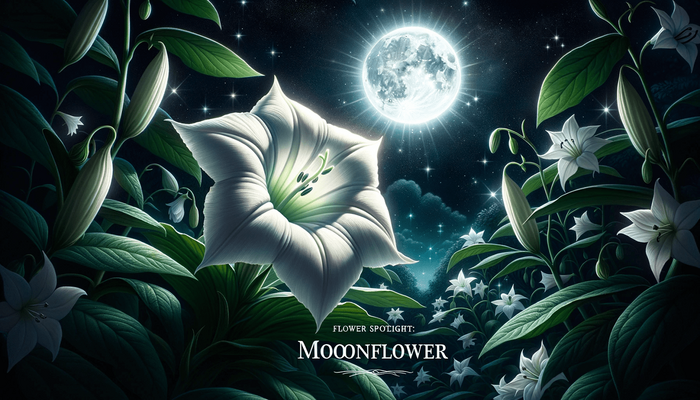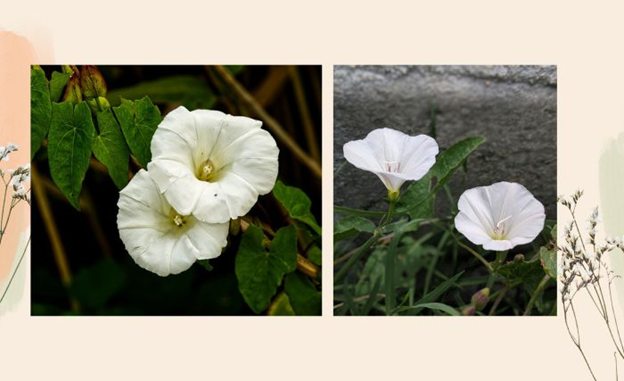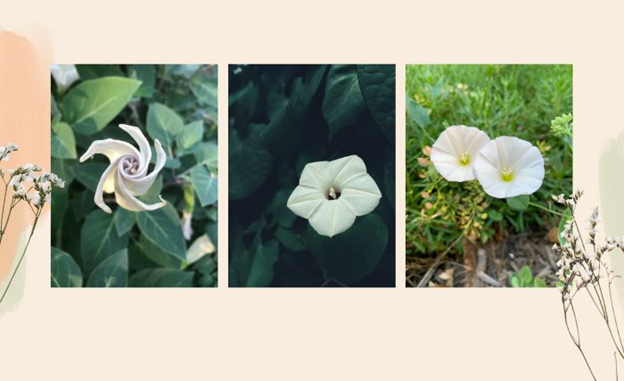Flower: Spotlight Moonflower

Have you ever seen a flower that wakes up when the world goes to sleep? Meet the moonflower plant, a climbing moon vine flower famous for its nocturnal blooming habit. Each evening, the moonflower's large white blossoms unfurl, releasing a sweet, intoxicating fragrance into the night air. By morning, the petals close as if they were never there, making moonflower at night a truly magical sight. Gardeners often include moonflowers in their evening gardens as spotlight flowers that practically glow under the moonlight. In this introduction, we'll explore what makes the moonflower so alluring – from its night-blooming nature to the mystique it brings to any moonlit garden.

History and Origins
The moonflower has a rich history rooted in tropical and subtropical America. Botanically known as Ipomoea alba (a member of the morning glory family), it is native to tropical regions of North and South America including parts of Mexico, Florida, the West Indies, and as far south as Argentina. Its common name "moonflower" comes from its pure white, round blooms that open in the evening and resemble a full moon in the night garden. Early records show that European explorers were fascinated by this plant. It was first documented by Europeans in the 1520s on the island of Hispaniola, where indigenous Taíno people called it "y". Not only did the locals admire its beauty, they also found clever uses for it.
The Journey of the Moonflower Through History
Native to tropical America, used by indigenous peoples. Mesoamerican cultures mixed its sap with natural latex to create rubber for ball games.
First documented by European explorers on the island of Hispaniola, where Taíno people called it "y".
Moonflowers being cultivated in botanical gardens of Europe, including Leiden in the Netherlands.
Documented in India, demonstrating how far the plant had spread from its American origins.
Became popular in Victorian gardens for its night-blooming characteristics and sweet fragrance.
Continues to be cherished in gardens worldwide, known for its pure white blooms that open at dusk and close by morning.
Remarkably, ancient Mesoamerican cultures used the moonflower vine's sap to help create rubber for bouncing balls – a process that predated Charles Goodyear's vulcanization by centuries. Spanish chroniclers noted that mixing moonflower vine juice with natural latex produced durable rubber for the Aztec and Maya ballgames. Enchanted by its uses and beauty, Europeans soon brought moonflower seeds back to the Old World. Historical records indicate that by around 1606, moonflowers were being grown in the botanical gardens of Europe (for example, in Leiden, the Netherlands). For over 300 years since, the moonflower has twined its way around trellises worldwide as both an ornamental and a medicinal herb. In some parts of Asia, it even picked up local names (it was recorded in India by the 1660s), showing how far this plant travelled from its American origins. Through the years, the moonflower's allure of blooming at night kept it in high demand. From cottage gardens in Victorian England to tropical courtyards in Asia, this night-blooming marvel has been cherished for generations.

Moonflower Symbolism and Meaning
Love and Desire
Many cultures link the moonflower to romantic love. In Victorian times, brides sometimes included moonflowers in bouquets as symbols of love and fidelity, captivated by the bloom's seductive night fragrance. Its short-lived yet beautiful bloom can also symbolize the intensity of a passionate moment.
Dreams and Mystery
Blooming in darkness, the moonflower evokes a sense of magic and dreaminess. Its otherworldly night-time presence has long made people think of mystery and enchantment – almost like a dream that appears at night and vanishes by dawn. It's no surprise some see it as a flower of dreams, encouraging us to embrace the unknown.
Lunar & Feminine Energy
The moonflower is strongly associated with the moon and the divine feminine across cultures. Its nightly bloom and gentle glow are linked to lunar goddesses and feminine qualities of intuition and creativity. For example, in Hindu mythology the moonflower represents creation and the goddess energy, while in Chinese lore it is associated with beauty, love, and even immortality. In this way, the flower embodies the soft, nurturing power of moonlight.

Transformation & Enlightenment
The flower's daily cycle of blooming and closing can symbolize renewal, transformation, and spiritual enlightenment. Some spiritual traditions regard the moonflower as a sign of the soul's awakening – blossoming in darkness and shining with inner light. Seeing a blossom open at night can feel like a gentle reminder that light can emerge even in dark times.
Each meaning adds to the moonflower's allure. Whether you view it as a emblem of love or a symbol of mystical insight, this flower carries a poetic message: even in the darkest night, beauty and hope can bloom.
Growing Tips
Growing moonflowers is rewarding even for beginner gardeners. This moon vine is vigorous and easy to grow, often reaching 3–6 metres in a single season if happy. Here are some simple tips to plant and care for your moonflower.
Planting from Seed
Moonflower is usually grown from seeds. For better germination, you can soak the tough seeds in water overnight before planting (this softens them), though they often sprout well without it. Sow seeds about 2.5–5 cm deep in warm soil after the last frost date. Space them around 12–15 cm apart so each vine has room to grow. In cold climates, you might start seeds indoors a few weeks early – just use peat pots or biodegradable containers since moonflowers don't like their roots disturbed when transplanting.
Sunlight and Soil
Choose a sunny spot for your moonflower. Full sun to partial shade is ideal, but more sun encourages more blooms. Moonflowers aren't fussy about soil – they can tolerate average or even low-fertility soil as long as it's well-drained. (Too-rich soil or excessive fertilizer can lead to lots of leaves but fewer flowers, so no need to overfeed this plant.)
Support for Vines
As a climbing vine, a moonflower needs something to grab onto. Provide a trellis, fence, arbour, or even a porch railing for it to twine around. Once the vine starts growing, it will rapidly head upward. You can gently guide and tie young shoots to the support until they latch on. If you prefer a bushier plant or want to control its direction, pinch the tips of the vine after it grows a few centimetres; this encourages side branches and can direct the vine where you want it.
Moonflower Growth Timeline & Care Guide
indoors
outdoors
blooms
flowering
seeds
Maximum Height
3-6 meters
Watering Needs
Weekly
Sun Requirements
Full Sun
Planting Depth
2.5-5 cm
Water and Maintenance
Moonflowers like regular water, especially in the beginning. Water about once a week, or more frequently in very hot, dry weather. They are somewhat drought-tolerant once established, so they forgive you if you forget a watering now and then. Overall they're low-maintenance – you typically won't need to fertilize, and they have few pest issues. In late summer, you can trim the vine if it gets too rampant. Remove spent blooms if you want to prevent it from self-seeding everywhere. At the end of the season (fall), cut down the vine after it dies back, and collect seeds for next year if desired.
Season and Climate
Being a tropical plant, moonflower thrives in warm weather. In Australian climate zones 2-3 (tropical and subtropical) it can act as a perennial and bloom nearly year-round, but in cooler zones it's grown as an annual (replanted each spring). If an early frost threatens in fall, you can cover the vine to prolong its bloom a bit, but generally it will die back in cold. Save some of the plentiful seeds to sow next year. With a little planning, you'll have fresh moonflower vines every summer to light up your nights!
Safety Note
Keep in mind that all parts of the moonflower plant (especially seeds) are poisonous if ingested. Like many members of the morning glory family, its seeds contain compounds that can cause illness. So, plant your moonflowers out of reach of curious children and pets, and wash hands after handling the seeds or vines. Enjoy its beauty, but don't eat it!
Benefits and Uses
Why grow a moonflower? There are many delightful benefits and uses for this unique plant, from practical gardening perks to cultural and even medicinal aspects:
Night-time Beauty & Fragrance
The most obvious benefit is the evening show it puts on. Moonflowers turn your garden into a nocturnal oasis. When most other blooms have closed for the day, the moonflower opens wide, reflecting moonlight with its white petals and releasing a soft, sweet perfume. If you enjoy relaxing outdoors in the evenings or entertaining friends on the patio at night, moonflowers will provide a lovely backdrop. They create a focal point in "moon gardens" (gardens designed with white or silver plants that are visible at night), essentially acting like natural lanterns amid the dark foliage. Their fragrance is often described as soothing and inviting – a real treat on a summer night.
Wildlife Attraction
Moonflowers are not only pleasing to people; they are also helpful to certain pollinators. Night-flying moths – especially large sphinx or hawk moths – are drawn to the blooms' fragrance and color. As these moths sip nectar, they pollinate the flowers. In some regions, even bats may visit moonflower blooms to investigate their scent or to eat the insects around them. By planting moonflowers, you support these nocturnal creatures. It's quite a sight to occasionally see a hummingbird-like moth hovering around a moonflower at dusk! In the daytime, although the blooms are closed, the vine's leafy growth can provide cover for small garden animals or shade for soil.
Garden Aesthetics and Practical Use
As a fast-growing vine, moonflower can be used to quickly cover a trellis or unsightly fence with lush green leaves and beautiful flowers. By day, the large heart-shaped leaves are attractive in their own right, and by night the blooms steal the show. This makes moonflower an excellent choice for creating a privacy screen that is attractive 24/7. Moreover, the rapid growth and vining habit mean you can create temporary summer shade over a pergola or porch by guiding moonflowers to climb overhead. The result is not just visual appeal but also a bit of cooling greenery in the heat of summer.
Cultural and Medicinal Uses
Throughout history, the moonflower has been more than just a pretty face in the garden. Traditionally, various cultures found medicinal uses for the plant. For instance, in folk medicine the moonflower has been used to reduce inflammation and treat pains like headaches. One compound identified in the plant, called scopoletin, has shown anti-inflammatory and pain-relieving properties in studies. (Of course, any medicinal use should be approached with caution due to the plant's toxicity.) An older medicinal application recorded in herbal texts is using parts of the moonflower vine to help treat snakebites – likely as a poultice or drink in traditional remedies. This highlights how communities saw the moonflower as a healing gift from nature. Additionally, the moonflower's role in making rubber for Mesoamerican ballgames stands out as an ingenious practical use of plant chemistry – not something that benefits a home gardener today, but a fascinating historical contribution to technology!
Spiritual and Emotional Benefits
For spiritual seekers, the moonflower can hold a special place in the garden. Many people find that tending night-blooming flowers encourages a moment of mindfulness and calm in the evening. Watching a bud slowly spiral open after sunset can be almost meditative. In some spiritual practices, moonflower blossoms are used as part of moonlit rituals or as offerings to represent transformation and the unfolding of enlightenment. Even on a personal level, growing a moonflower can remind one to find beauty in the quiet, dark moments of life. Its presence might inspire journal entries, art, or simply a sense of peace as you inhale its evening fragrance. In essence, the moonflower invites us to slow down and appreciate nature's night-time palette.
Whether you value it for its garden charm, its wildlife support, or its symbolic resonance, the moonflower is a plant that gives generously. It asks only for a bit of sun and support to climb, and in return it offers months of mystical nights and a connection to a long lineage of plant lore.
Folklore and Myths
It's no surprise that a flower as intriguing as the moonflower has gathered its share of folklore and myths. Around the world, people have woven stories about this nocturnal bloom, blending fact and imagination:
Legends of Lunar Origin
Many old tales link the moonflower to the moon itself. One lovely folktale from Asia tells of the Moon who, feeling pity for night travellers, sent down a piece of herself in the form of a glowing white flower to light their way. Indeed, the flower's habit of opening at night has earned it nicknames like "moon's gift" in some cultures. Such stories highlight the idea of the moonflower as a symbol of light in darkness – a small guardian in the night. While the specifics vary, the theme is often that the moonflower was born from moonlight or stars, giving it an ethereal connection to the heavens.
Witches and Night Magic
In European folklore, the name "moonflower" was sometimes associated not with Ipomoea alba but with other night-blooming, mystical plants – particularly a type of datura. These plants were thought to be ingredients in witchcraft and potions. For example, a poisonous moonflower (also known as jimsonweed) had such a notorious reputation that the French called it herbe du diable ("devil's herb"). Tales from centuries past tell of witches using these moonflowers in brews to induce hallucinations or trance states, fuelling stories of midnight rites and magical flights. Such folklore gave the moonflower an aura of danger and mystery, associating it with witches, spells, and the spirit world. (Of course, the moonflower vine in your garden isn't casting any spells, aside from enchanting you with its beauty!)

Divine Feminine and Creation Myths
As mentioned earlier, Hindu mythology cherishes the moonflower as a manifestation of the divine feminine. One myth says that a moon goddess created the moonflower to represent her eternal cycle of creation, growth, and rebirth – blooming and fading, night after night, in harmony with the lunar phases. In some Hindu stories, this flower is offered in temples during evening worship, symbolizing purity and the creative power of the night. The moonflower's pristine white colour and opening after dusk made it a natural emblem for goddesses of the moon.
Myths of Eternal Love
A recurring theme in moonflower lore is that of love that defies darkness. There are romantic legends, for instance, of star-crossed lovers whose souls were turned into moonflowers so they could reunite and bloom together every night. In one poetic legend, a young woman waits each night for her lover to return from war; she plants moonflower seeds by her door, and when the flowers finally bloom under a full moon, her lover appears – having followed the glow of the blossoms. Such stories use the flower as a metaphor for hope and love shining through the dark. While these are just stories, they add a layer of romance to the moonflower's reputation.
These diverse myths and folklore from around the world amplify the moonflower's mystique. Whether seen as a gift from a benevolent moon, a tool of midnight magic, or a token of eternal love, the moonflower captivates the imagination. When you grow a moonflower, you're not just planting a vine; you're also planting a story – one that has been told and retold under the gentle light of the moon.
Conclusion
In the hush of a warm summer night, a moonflower unfurls – and for a few hours, the ordinary world is transformed. There is something undeniably poetic about this plant that saves its splendour for the darkness. Perhaps it teaches us a subtle lesson: that even in dark times or places, there can be breathtaking beauty. The moonflower, with its history stretching from ancient rubber-makers to Victorian romantics, and its symbolism touching on love, mystery, and spiritual growth, truly earns its place in both gardens and legends. For gardeners and flower enthusiasts, it's a living marvel – a vine that grows with gusto and then pauses each dusk to put on a show. For spiritual seekers, it's a reminder of the magic that exists in the natural rhythms of life: the setting sun, the rising moon, the opening flower, the closing petals. Watching a moonflower at night can feel like witnessing a secret whispered by nature just for you. In closing, the moonflower is special not only because it blooms at night, but because it invites us to experience our world in a different light (literally!). It invites humming moths and dreaming humans alike to come appreciate the night. So if you ever find yourself yearning for a bit of wonder, consider planting a moonflower. By the time it first blossoms under the stars, you'll understand why this plant has been adored for centuries. In the spotlight of the moon, the moonflower glows – a gentle beacon of beauty, hope, and a little midnight magic.
Sources
Blog Categories
Recent posts
- What 17 Years of Orders Taught Us About Toowoomba’s Flower Tastes
- 12 Christmas Wreath Decorating Ideas and Tips
- Do’s and Don’ts When Sending Christmas Flower Gifts
- The Significance of Christmas Colours in Flower Arrangements
- Stop BBQ Flowers Wilting: An Expert Guide to Flowers That Survive the Heat
- How to Select Birthday Flowers for a Man
